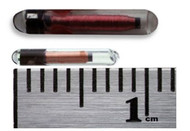A Review of the National Theft Register and Its Objectives For The Future
Posted by Pet theft, Pet Theft Awareness Day, stolen pets, stolen Parrots on 9/4/2025
Did you know that it is Pet Theft Awareness Day on the 14th February?
Pet Theft Awareness
The day was started in 1988 by an organisation called Last Chance for Animals , to tell people how to keep their animals safe from thieves. Millions of animals are stolen around the world every year, and although there are many happy endings with owners reunited with their treasured pets after they are lost or stolen, other people are not so lucky and never see their beloved animal again.

In the UK, The National Theft Register records thefts, losses and recoveries of exotic species, which includes zoological birds, reptiles and other animals, in the hope these animals will eventually be reunited with their owners.
John Hayward
We asked John Hayward, who was one of the founders of the National Theft Register, to explain what the organisation does and the methods that pet owners can use to reduce the risk of their animal being stolen. This is what he had to say:
?The National Theft Register will shortly celebrate its twenty years of existence. It was set up in 1995 at the request of the then Federation of Zoos (since renamed BIAZA) to collate all zoological species stolen throughout the UK.
I was invited to develop this agency as a specialist in CITES and exotic species.
Thefts
In the early years there were numerous thefts being committed, especially in relation to Parrots, Cockatoos and Macaws, in order to feed both the national demand and further afield throughout the world. It was quite usual for upwards of fifty such crimes taking place each year.
As time has moved on and with regular press and publicity, and increasing general awareness, this aspect of criminality has been greatly reduced. This has been achieved by the development of lower cost security systems and the vigilance and care of animal keepers, whether they be the larger collections or the small private pet owner.
Register
To be more precise, during the last twelve months the Register has dealt with twelve Parrot thefts, all of which appear to be unrelated ?one-off? crimes and certainly not the work of organised gangs.
This is a noticeable improvement compared to past years, however we are now suffering from an on-going series of planned thefts of the smaller species especially exhibition Budgerigars, Canaries and Finches, of which fourteen incidents have been reported.
In addition, four cases of Tortoise thefts have been reported together with Bantams at Bristol, Tamarins at Blackpool, an Eagle Owl in Cumbria and Cuckoos in Holland.
DNA
There have been a number of successful prosecutions in recent years where custodial sentences have been secured, often as the result of the development of DNA for evidential purposes. This has proved to be a significant preventative feature of the work of the Register working closely with the police and other agencies, especially the National Police Wildlife Crime Intelligence Unit.
It is often stated by the Register that security should be considered a vital element of good animal husbandry. Crime prevention technology can be easily installed both in the home and externally to protect outside bird-houses and aviaries. These can include alarms, lighting, CCTV, dial-out units to alert mobile phones whether ?hard-wired? of by wireless contact or beam systems.
Additionally we must address the matter of all animal identification, especially those species of birds, reptiles and small primates that are the more regular target of the thieves. The main objective during 2014, and now into the future, is the method of both ringing birds and more particularly the use of microchips.
Microchip
Find out more about microchipping your Parrot here.
All animals should be positively identifiable for the purposes of evidence to assist in their recovery, whenever stolen or coming into the wrong hands. It is difficult and frustrating for the police and other agencies to carry out successful operations without such information as to lawful ownership.

Last year The Parrot Society released the ?Pet Parrot Passport,? which can be adapted for all species of animals. Details of ID should be safely guarded and kept private. Seriously consider the microchip secure registration service and the additional protection of specialist insurance, which also affords the facility to record the animal?s details again in confidence.
2015
The message for 2015 is therefore to assess the risks of our pets from being stolen, install the best security money can buy to protect your pet and microchip all your animals where appropriate.
The thieves are still out there and we must deter them as best we can and prevent our animals from being stolen.?
Find out about lost Parrots that have been reunited with their owners here and more advice on recovering them here.

